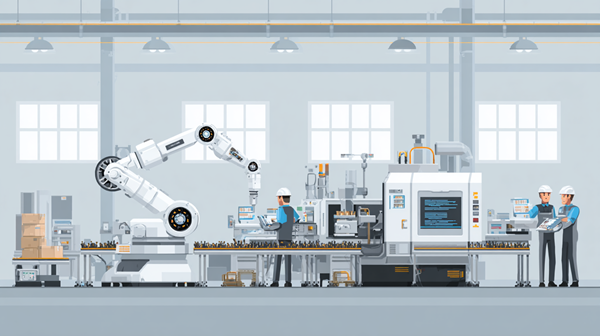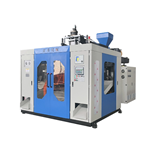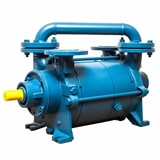Discover the top industrial automation trends shaping Australia in 2025. Learn how AI, cobots, digital twins, and edge computing can boost your business efficiency and cut costs today.
Key takeaways
- 40% of Australian SMEs were adopting AI by Q4 2024, up 5% from the previous quarter, demonstrating steady growth in AI integration across smaller businesses.
- Cobots deployments in Australian SMEs are on the rise, with the national robotics market forecast to grow at double-digit rates through 2025 under the National Robotics Strategy.
- Predictive maintenance powered by AI and IoT can reduce unplanned downtime by 20–40% and cut maintenance costs by up to 25%, driving significant ROI in industries from energy to manufacturing.
- Digital twins are gaining traction in major infrastructure and utilities projects following the 2021 Digital Twin Blueprint, offering real-time simulation and lifecycle insights.
- Edge computing deployments are expanding in agritech and mining operations across Queensland and WA, enabling real-time decision-making despite limited connectivity.
- 61% of Australian businesses report difficulty recruiting for roles requiring advanced technical or AI skills, highlighting a critical upskilling need.
Introduction
As we move through 2025, industrial automation in Australia is evolving faster than ever. Whether you're in manufacturing, mining, construction, or logistics, automation is no longer just a cost-saving tool — it's a driver of competitive advantage, sustainability, and workforce safety.
With global disruptions, labour shortages, and rising pressure for efficiency, Australian companies are turning to smart technologies to stay ahead. In this article, we’ll explore the top automation trends shaping the year ahead — and show how your business can act on them now.
AI and machine learning: The brains behind modern automation
Artificial intelligence (AI) and machine learning (ML) are increasingly central to automation strategies across Australian industry.
- Smart manufacturing: AI is helping manufacturers predict demand, optimise inventory, and automate quality control.
- Real-time optimisation: AI models can adjust machine settings on the fly to maximise throughput and minimise defects.
- Australian trend: A 2024 survey by PwC found that 47% of Australian manufacturers had implemented some form of AI automation, up from 32% the year prior.
Your business can benefit by starting small — automating specific data-driven tasks like forecasting or inspection — before scaling across the operation.
Cobots and robotics: More flexible, safer automation
Cobots — collaborative robots that work alongside humans — are reshaping automation accessibility.
- Workforce augmentation: Cobots are ideal for repetitive, dangerous, or ergonomically difficult tasks.
- Deployment in SMEs: Lower upfront costs and easier programming mean SMEs can now integrate robotics affordably.
- Australian growth: Robotics Australia Group projects a 12% annual growth rate in cobot deployment through 2025.
For example, Australian food processors and packaging companies are rapidly adopting cobots to improve efficiency while maintaining quality and compliance.
Predictive maintenance: Keeping operations running
Predictive maintenance uses sensors, AI, and IoT to detect signs of wear or failure before breakdowns occur.
- Less downtime: Can reduce unplanned outages by 20–40%.
- Lower costs: Helps cut maintenance spend by up to 25% compared to reactive servicing (CSIRO, 2024).
- Example: Mining and heavy equipment operators in WA are deploying predictive systems on excavators and conveyors to maximise uptime during peak operations.
If your operations rely on expensive or remote machinery, predictive maintenance offers one of the fastest ROIs in automation.
Digital twins: Virtual models of physical assets
A digital twin is a real-time digital replica of a physical asset or process, used to simulate, monitor, and optimise performance.
- Construction and infrastructure: Used in rail, roads, and utilities for planning and lifecycle management.
- Mining and processing plants: Operators are modelling entire sites to simulate changes before implementation.
- Australian examples: The Western Sydney International Airport and Snowy Hydro 2.0 both use digital twins for real-time project visibility and risk management.
Digital twins are especially valuable when you’re managing high-value assets or planning expansions.
Edge computing: Enabling faster, local decision-making
Edge computing places data processing closer to the source — ideal for Australia’s dispersed industrial operations where cloud access may be limited.
- Low latency: Real-time decisions for machinery, robotics, and safety systems.
- Resilience: Maintains performance in remote areas without relying on constant internet.
- Use case: In Queensland and Western Australia, agritech and mining operations are deploying edge devices for autonomous equipment and environmental monitoring.
If your operation is outside major cities, edge computing could solve your connectivity bottlenecks.
Automation and sustainability: Going hand-in-hand
Sustainability targets are becoming central to operational strategy — and automation is a key enabler.
- Energy monitoring: Automated systems can monitor and reduce energy consumption in real time.
- Waste reduction: AI-driven process control cuts materials waste in manufacturing and food processing.
- Carbon tracking: Automated reporting tools help meet ESG and compliance requirements, especially under the Climate-Related Financial Disclosure laws coming in 2025.
Businesses aligning automation with sustainability are more attractive to investors, regulators, and customers alike.
Workforce integration: Skills, not job cuts
Contrary to fears, automation isn’t eliminating jobs — it’s transforming them.
- New skill demand: Operators, technicians, and engineers are now expected to manage, troubleshoot, and analyse smart systems.
- Upskilling required: Programs like the Victorian Government’s Digital Jobs program and the national Skills for the Future initiative are helping to close gaps.
- Trend: 61% of Australian employers say automation is increasing demand for technical and analytical skills (Ai Group, 2024).
Investing in workforce training will maximise your ROI on automation and build internal champions for change.
Risks and how to mitigate them
While industrial automation offers significant benefits, it’s important to be aware of potential risks that can impact your project’s success. Understanding these challenges upfront—and how to address them—will help your business avoid costly setbacks and maximise return on investment.
Underestimating integration complexity
Integrating new automation technologies with your existing systems can be more complicated than anticipated. Fragmented legacy equipment or incompatible software can cause delays and extra costs.
- Mitigation: Start by automating a single process or system, then gradually expand as you gain experience. Work closely with technology vendors who offer strong support and proven integration expertise.
Lack of skilled operators and workforce readiness
Automation requires staff who understand how to operate, monitor, and maintain new technologies. Without proper skills, your automation may underperform or cause disruptions.
- Mitigation: Invest early in upskilling your workforce through training programs, workshops, or partnerships with local training providers. Consider programs like Victoria’s Digital Jobs initiative or industry apprenticeships.
Choosing the wrong technology for your needs
Not all automation solutions deliver the same value, and the cheapest or flashiest option may not suit your operation. Misaligned technology can waste time and money.
- Mitigation: Conduct a clear needs assessment focused on ROI, scalability, and local vendor support. Pilot new systems on a small scale before committing to full deployment.
Ignoring cybersecurity risks
Increasing connectivity through IoT devices and cloud platforms exposes your systems to potential cyber threats. Security breaches can cause operational downtime and data loss.
- Mitigation: Include cybersecurity in your automation planning. Ensure all devices and software meet Australian cybersecurity standards, and regularly update your systems and staff training on security best practices.
By proactively addressing these risks, your business can confidently navigate automation adoption and position itself for long-term success in Australia’s competitive industrial landscape.
Conclusion
From cobots to digital twins, Australia’s industrial automation landscape is being reshaped by smart technologies that are now more accessible, affordable, and scalable than ever. By staying ahead of these trends, your business can boost efficiency, reduce risk, and remain competitive in a high-cost, high-expectation environment.
Start by evaluating which trend fits your current needs — and build from there. In 2025, automation isn’t a future concept. It’s the new standard.







